Multi-Zone Energy Performance Assessment of Algerian Social Housing Using a Parametric Approach
Abstract
:1. Introduction
| Studies | Year | Insulation | Property Glazing | WWR | Orientation | Airtightness | Solar Absorption | Internal Heat Gain | Form | Thermal Inertia | Thermal Regulations |
|---|---|---|---|---|---|---|---|---|---|---|---|
| Magnier and Haghighat, Canada, Residential [7] | 2010 | x | x | x | |||||||
| Yusuf Yyldyz et al., Turkey, Hot and humid climate [10] | 2011 | x | x | x | x | ||||||
| Asadi et al., Portugal, Residential [11] | 2012 | x | x | ||||||||
| Vasco Granadeiro et al., Lisbon [14] | 2013 | x | |||||||||
| Rodr’ıguez et al., Spain, Residential [24] | 2013 | x | x | x | |||||||
| Huang et al., Taiwan, Residential [13] | 2016 | x | x | x | x | ||||||
| La¨etitia Arantes et al., Grenoble (France) [25] | 2016 | x | |||||||||
| Hamdy et al., Netherlands, Residential [12] | 2016 | x | |||||||||
| O’Neill and Niu, USA, Residential [26] | 2017 | x | |||||||||
| Chen and Yang, Hong Kong, Residential [27] | 2017 | x | x | ||||||||
| Mitja Kosira et al., Central Europe [28] | 2018 | x | |||||||||
| Harkouss et al., Lebanon, Residential [29] | 2018 | x | x | x | |||||||
| Gou et al., China, Residential [30] | 2018 | x | x | x | x | x | x | x | |||
| Chen and Yang, China, Residential [31] | 2018 | x | x | x | x | x | x | ||||
| Ferrara et al., Italy, Residential [32] | 2019 | x | x | ||||||||
| Ascione et al., Italy, Residential [33] | 2019 | x | x | x | |||||||
| Shadram et al., Subarctic, Residential [34] | 2020 | x | x | ||||||||
| Salata et al., Italy, Residential [35] | 2020 | x | x | x | |||||||
| Rosso et al., Italy Residential [36] | 2020 | x | x | x | |||||||
| Yujun Jung et al., S. Korea, Residential [22] | 2021 | x | x | x | x | x | x | x | x | ||
| Michael A, William et al., Egypt [37] | 2021 | x | |||||||||
| Mehhrdad Rabani et al., Norv`ege [38] | 2021 | x | x | x | |||||||
| Nasrollah Nasrollahzadeh [39] | 2021 | x | x | x | |||||||
| Ning Li Pekin, China [40] | 2022 | x | x | x | |||||||
| Lihua He and Lin Zhang, China [41] | 2022 | x | x | ||||||||
| Magdi Rashad [42] | 2022 | x | x | ||||||||
| ALGERIA | |||||||||||
| Mohamed Khadraoui et al., Algeria, arid climate [15] | 2017 | x | x | x | |||||||
| Nait Nadia et bourbia Fatiha, Algeria, semi-arid climate [16] | 2019 | x | |||||||||
| Messaouda Rais et al., residential building, Algeria [19] | 2020 | x | x | x | x | ||||||
| Mounira Badeche, office building, Algeria [20] | 2020 | x | x | x | |||||||
| Marco Morini, Algeria [20] | 2021 | x | x | x | |||||||
| Abdelkader Sarri, Algeria [17] | 2021 | x | |||||||||
| Meryem Kadri, Algeria [21] | 2021 | x | x | x | |||||||
| Soumia Rahmani, Algeria [18] | 2022 | x | x | ||||||||
| Present research | 2023 | x | x | x | x | x | x | x |
2. Materials and Methods
2.1. Description of the Case Study
2.1.1. The Shape Factor (SF) (m2/m3)
2.1.2. Heat Transfer Coefficient (U) (W/m2 k)
2.1.3. Climate
2.2. Empirical Approach
2.2.1. Measurement Protocol
2.2.2. Measuring Instrument
2.3. Parametric Approach
2.3.1. Simulation Software
2.3.2. Simulation Conditions
- Climate Data: Meteonorm 8.0.3.15910 software was utilized to collect climatic data as input in the Trnsys software for the three regions of interest in this study: Gdyel (Oran) in a Mediterranean climate, Oum El Bouaghi, and Constantine in a semi-arid climate.
- Infiltration: To simulate infiltration as input for Type 56a, Type 571 was employed in the simulation studio. The coefficients (K) for multiple linear regression were defined based on the building’s constructive state, with medium K values of K1 (0.10), K2 (0.017), and K3 (0.049) utilized in this study, as shown in Table 5. It is crucial to highlight that the case study building was constructed in 2008.
- Orientation and Windows: New orientations, including southeast, southwest, northeast, and northwest, were generated in TRNSYS to ensure that windows and walls were oriented correctly.Modeling in TRNBuild: The resulting multi-zone model in TRNBuild encompasses 18 zones, which detailed the building’s geometry and thermal properties for the two upper levels, each containing two apartments and the staircase, which were designed to maintain heat exchange continuity with both external and internal spaces. The material properties are summarized in Table 4.
- Scenarios (occupancy schedule, heating and cooling loads): This study considered two scenarios for occupancy and energy demand for heating and cooling:Scenario (A): This is a real-life measurement scenario already defined in the empirical part of this study, as shown in Figure 3. Energy loads were calculated for a temperature demand of 30 °C in winter and 27 °C in summer.Scenario (B): This is a standard scenario for the lifestyle of an Algerian family, as shown in Figure 6, in which the demand for heating or cooling depends on the occupancy. The occupancy schedule was planned with a set temperature of 21 °C in winter and 27 °C in summer.
- Gains: Internal gains were taken into account, including the use of computers, artificial lighting, and other heat-generating devices such as ovens in the kitchen (zone 4), summarized in Table 6.
3. Results and Discussion
3.1. Model Validation (Uncertainty Study)
3.2. Regulatory Assessment (Compliance with DTR C3-4)
3.3. Results of the Empirical Part
Measured Results
3.4. Results of the Parametric Modeling
3.4.1. Thermal Comfort
3.4.2. Energy Consumption
3.4.3. Shape Factor
4. Conclusions
Author Contributions
Funding
Data Availability Statement
Conflicts of Interest
Abbreviations
| TEP | Tonnes of equivalent petroleum. |
| LSP | Participatory social housing. |
| DTR | Algerian thermal regulatory document. |
| AADL | National Housing Improvement and Development Agency. |
| SF | Shape factor (m2/m3). |
| SFZ | Shape factor per zone (m2/m3). |
| U | Heat transfer coefficient (W/m2 k). |
| K | Coefficients for multiple linear regression infiltration. |
| NMBE | Mean bias error. |
| RMSE | Root mean square error. |
| CV(RMSE) | Coefficient of variation of the root mean square error. |
| Ex | Exterior. |
| IN | Interior. |
| IN-S-EX-WA | Interior surface temperature of the external wall. |
| TF | Top floor. |
| IF | Inter-floor. |
| T | Temperature (°C). |
| S (A) | Scenario (A) (experience scenario). |
| S (B) | Scenario (B) (standard scenario). |
| WWR | Window-to-Wall ratio |
| OEB | Oum El Bouaghi |
References
- Ciardiello, A.; Rosso, F.; Dell’Olmo, J.; Ciancio, V.; Ferrero, M.; Salata, F. Multi-objective approach to the optimization of shape and envelope in building energy design. Appl. Energy 2020, 280, 115984. [Google Scholar] [CrossRef]
- Nabil, M.; Labidine, M.Z. Application Efficiency Measures Through TRNSYS Software on Algerian Building to Save Energy. J. Adv. Res. Fluid Mech. Therm. Sci. 2022, 93, 160–172. [Google Scholar] [CrossRef]
- Mohammedi, A.; Sahli, Y.; Mohammed Benhammou, H.; Ben Moussa, H. PEMFC Channel Cross-Section Shape: Study, Analyze and Optimization. J. Renew. Energ. 2021, 24, 179–187. [Google Scholar]
- (APRUE). APRUE L’Agence Nationale pour la Promotion et la Rationalisation de l’Utilisation de l’Energie. Available online: http://www.aprue.org.dz/ (accessed on 27 July 2022).
- Morini, M.; Calabrese, N.; Chello, D. Proposals for the Thermal Regulation of Buildings in Algeria: An Energy Label for Social Housing. Int. J. Archit. Environ. Eng. 2021, 15, 465–471. [Google Scholar]
- Morini, M. Guide RTB+. 2021, pp. 1–28. Available online: www.enea.it (accessed on 14 February 2023).
- Magnier, L.; Haghighat, F. Multiobjective optimization of building design using TRNSYS simulations, genetic algorithm, and Artificial Neural Network. Build. Environ. 2010, 45, 739–746. [Google Scholar] [CrossRef]
- Dardouri, S.; Mankai, S.; Almoneef, M.M.; Mbarek, M.; Sghaier, J. Energy performance based optimization of building envelope containing PCM combined with insulation considering various configurations. Energy Rep. 2023, 10, 895–909. [Google Scholar] [CrossRef]
- Luo, Y.; Zhang, L.; Bozlar, M.; Liu, Z.; Guo, H.; Meggers, F. Active building envelope systems toward renewable and sustainable energy. Renew. Sustain. Energy Rev. 2019, 104, 470–491. [Google Scholar] [CrossRef]
- Yildiz, Y.; Arsan, Z.D. Identification of the building parameters that influence heating and cooling energy loads for apartment buildings in hot-humid climates. Energy 2011, 36, 4287–4296. [Google Scholar] [CrossRef]
- Asadi, E.; da Silva, M.G.; Antunes, C.H.; Dias, L. A multi-objective optimization model for building retrofit strategies using TRNSYS simulations, GenOpt and MATLAB. Build. Environ. 2012, 56, 370–378. [Google Scholar] [CrossRef]
- Hamdy, M.; Nguyen, A.-T.; Hensen, J.L.M. A performance comparison of multi-objective optimization algorithms for solving nearly-zero-energy-building design problems. Energy Build. 2016, 121, 57–71. [Google Scholar] [CrossRef]
- Huang, K.-T.; Hwang, R.-L. Future trends of residential building cooling energy and passive adaptation measures to counteract climate change: The case of Taiwan. Appl. Energy 2016, 184, 1230–1240. [Google Scholar] [CrossRef]
- Granadeiro, V.; Duarte, J.P.; Correia, J.R.; Leal, V.M.S. Building envelope shape design in early stages of the design process: Integrating architectural design systems and energy simulation. Autom. Constr. 2013, 32, 196–209. [Google Scholar] [CrossRef]
- Khadraoui, M.A.; Sriti, L. Facades’ Thermal Behavior of the Office Buildings in a Hot and Arid Climate. Alger. J. Eng. Archit. Urban. 2017, 1, 28–38. [Google Scholar]
- Bourbia, F.; Nait, N. Ameloration De L Efficacite Energetique Des Batiments Par La Rehabilitation Thermique De L ’Enveloppe En Climat. In Proceedings of the Fifth International Conference on Energy, Materials, Applied Energetics and Pollution, Constantine, Algeria, 22–24 October 2019. [Google Scholar]
- Sarri, A.; Bechki, D.; Bouguettaia, H.; Al-Saadi, S.N.; Boughali, S.; Farid, M.M. Effect of using PCMs and shading devices on the thermal performance of buildings in different Algerian climates. A simulation-based optimization. Sol. Energy 2021, 217, 375–389. [Google Scholar] [CrossRef]
- Rahmani, S.; Kaoula, D.; Hamdy, M. Exploring the thermal behaviour of building materials: Terracotta, concrete hollow block and hollow brick, under the arid climate, case study of Biskra-Algeria. Mater. Today Proc. 2022, 58, 1380–1388. [Google Scholar] [CrossRef]
- Rais, M.; Boumerzoug, A.; Baranyai, B. Energy performance diagnosis for the residential building faç. Pollack Period. 2021, 16, 136–142. [Google Scholar] [CrossRef]
- Badeche, M.; Bouchahm, Y. Design optimization criteria for windows providing low energy demand in office buildings in Algeria. Environ. Sustain. Indic. 2020, 6, 100024. [Google Scholar] [CrossRef]
- Kadri, M.; Bouchair, A.; Laafer, A. The contribution of double skin roof coupled with thermo reflective paint to improve thermal and energy performance for the ‘Mozabit’ houses: Case of Beni Isguen’s Ksar in southern Algeria. Energy Build. 2022, 256, 111746. [Google Scholar] [CrossRef]
- Jung, Y.; Heo, Y.; Lee, H. Multi-objective optimization of the multi-story residential building with passive design strategy in South Korea. Build. Environ. 2021, 203, 108061. [Google Scholar] [CrossRef]
- Guideline, A.; Rae, A.S.H.; Rae, A.S.H.; Barker, K.A.; Landsberg, D.R.; Emmerich, S.J. ASHRAE Guideline 14-2014: Measurement of Energy, Demand, and Water Savings; American Society of Heating, Refrigerating, and Air Conditioning Engineers: Atlanta, GA, USA, 2002; Volume 4, Available online: https://webstore.ansi.org/standards/ashrae/ashraeguideline142014 (accessed on 26 May 2024).
- Calleja Rodríguez, G.; Carrillo Andrés, A.; Domínguez Muñoz, F.; Cejudo López, J.M.; Zhang, Y. Uncertainties and sensitivity analysis in building energy simulation using macroparameters. Energy Build. 2013, 67, 79–87. [Google Scholar] [CrossRef]
- Arantes, L.; Marry, S.; Baverel, O.; Quenard, D. Efficacité énergétique et formes urbaines: Élaboration d’un outil d’optimisation morpho-énergétique. Cybergeo Eur. J. Geogr. 2016. [Google Scholar] [CrossRef]
- O’Neill, Z.; Niu, F. Uncertainty and sensitivity analysis of spatio-temporal occupant behaviors on residential building energy usage utilizing Karhunen-Loève expansion. Build. Environ. 2017, 115, 157–172. [Google Scholar] [CrossRef]
- Chen, X.; Yang, H. A multi-stage optimization of passively designed high-rise residential buildings in multiple building operation scenarios. Appl. Energy 2017, 206, 541–557. [Google Scholar] [CrossRef]
- Košir, M.; Gostiša, T.; Kristl, Ž. Influence of architectural building envelope characteristics on energy performance in Central European climatic conditions. J. Build. Eng. 2018, 15, 278–288. [Google Scholar] [CrossRef]
- Harkouss, F.; Fardoun, F.; Biwole, P.H. Passive design optimization of low energy buildings in different climates. Energy 2018, 165, 591–613. [Google Scholar] [CrossRef]
- Gou, S.; Nik, V.M.; Scartezzini, J.-L.; Zhao, Q.; Li, Z. Passive design optimization of newly-built residential buildings in Shanghai for improving indoor thermal comfort while reducing building energy demand. Energy Build. 2018, 169, 484–506. [Google Scholar] [CrossRef]
- Chen, X.; Yang, H. Integrated energy performance optimization of a passively designed high-rise residential building in different climatic zones of China. Appl. Energy 2018, 215, 145–158. [Google Scholar] [CrossRef]
- Ferrara, M.; Rolfo, A.; Prunotto, F.; Fabrizio, E. EDeSSOpt—Energy Demand and Supply Simultaneous Optimization for cost-optimized design: Application to a multi-family building. Appl. Energy 2019, 236, 1231–1248. [Google Scholar] [CrossRef]
- Ascione, F.; Bianco, N.; Maria Mauro, G.; Napolitano, D.F. Building envelope design: Multi-objective optimization to minimize energy consumption, global cost and thermal discomfort. Application to different Italian climatic zones. Energy 2019, 174, 359–374. [Google Scholar] [CrossRef]
- Shadram, F.; Bhattacharjee, S.; Lidelöw, S.; Mukkavaara, J.; Olofsson, T. Exploring the trade-off in life cycle energy of building retrofit through optimization. Appl. Energy 2020, 269, 115083. [Google Scholar] [CrossRef]
- Salata, F.; Ciancio, V.; Dell’Olmo, J.; Golasi, I.; Palusci, O.; Coppi, M. Effects of local conditions on the multi-variable and multi-objective energy optimization of residential buildings using genetic algorithms. Appl. Energy 2020, 260, 114289. [Google Scholar] [CrossRef]
- Rosso, F.; Ciancio, V.; Dell’Olmo, J.; Salata, F. Multi-objective optimization of building retrofit in the Mediterranean climate by means of genetic algorithm application. Energy Build. 2020, 216, 109945. [Google Scholar] [CrossRef]
- William, M.A.; Suárez-López, M.J.; Soutullo, S.; Hanafy, A.A. Building envelopes toward energy-efficient buildings: A balanced multi-approach decision making. Int. J. Energy Res. 2021, 45, 21096–21113. [Google Scholar] [CrossRef]
- Rabani, M.; Bayera Madessa, H.; Mohseni, O.; Nord, N. Minimizing delivered energy and life cycle cost using Graphical script: An office building retrofitting case. Appl. Energy 2020, 268, 114929. [Google Scholar] [CrossRef]
- Nasrollahzadeh, N. Comprehensive building envelope optimization: Improving energy, daylight, and thermal comfort performance of the dwelling unit. J. Build. Eng. 2021, 44, 103418. [Google Scholar] [CrossRef]
- Li, N.; Peng, Z.; Dai, J.; Li, Z. Performance-Oriented Passive Design Strategies for Shape and Envelope Structure of Independent Residential Buildings in Yangtze River Delta Suburbs. Sustainability 2022, 14, 4571. [Google Scholar] [CrossRef]
- He, L.; Zhang, L. A bi-objective optimization of energy consumption and investment cost for public building envelope design based on the ε-constraint method. Energy Build. 2022, 266, 112133. [Google Scholar] [CrossRef]
- Rashad, M.; Żabnieńska-Góra, A.; Norman, L.; Jouhara, H. Analysis of energy demand in a residential building using TRNSYS. Energy 2022, 254, 124357. [Google Scholar] [CrossRef]
- Catalina, T.; Virgone, J.; Roux, J.; Blanco, E. Effet de l’inertie thermique, de la surface vitrée et du coefficient de forme sur les besoins en chauffage d’une habitation. Ibpsa 2008, 1–7. Available online: https://hal.science/hal-00411796 (accessed on 26 May 2024).
- ISO 7730; Ergonomics of the Thermal Environment—Analytical Determination and Interpretation of Thermal Comfort Using Calculation of the PMV and PPD Indices and Local Thermal Comfort Criteria. International Organization for Standardization: Geneva, Switzerland, 2005.

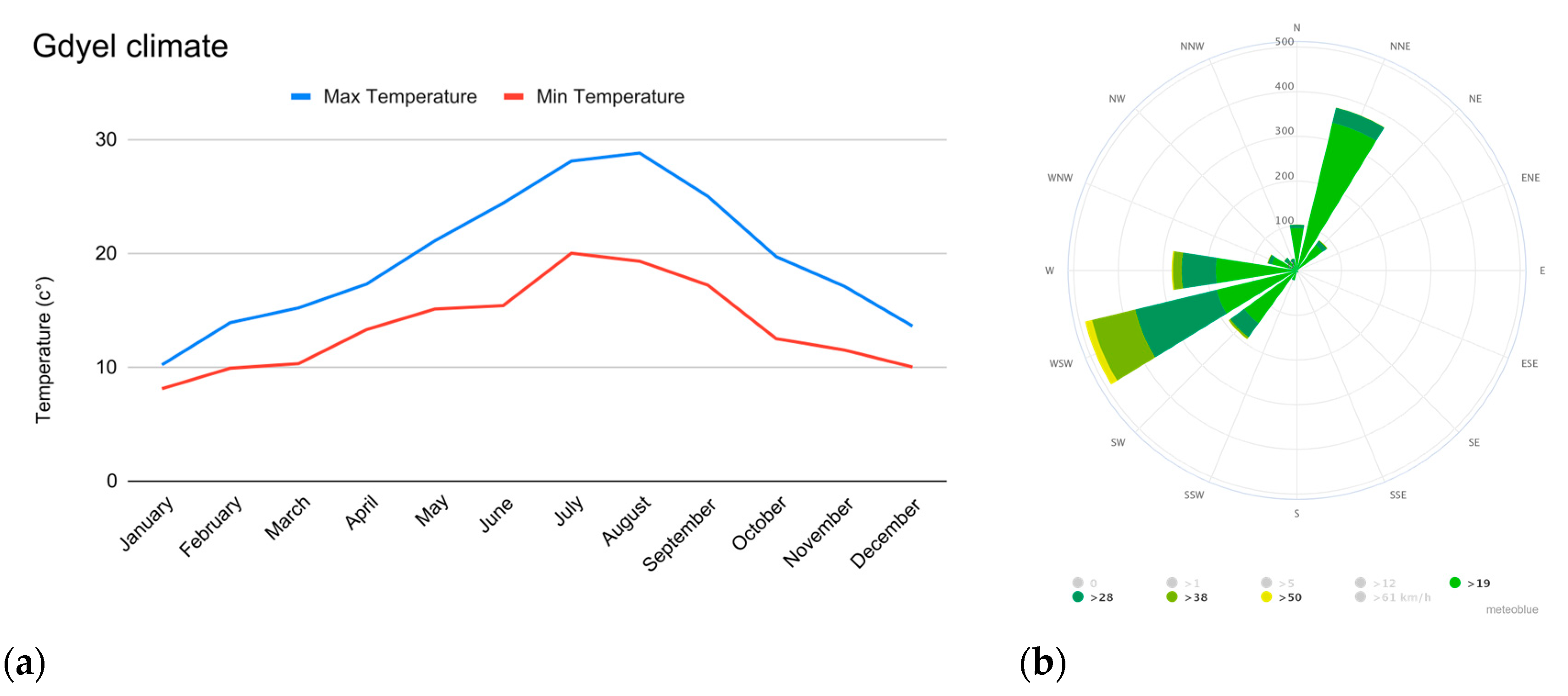

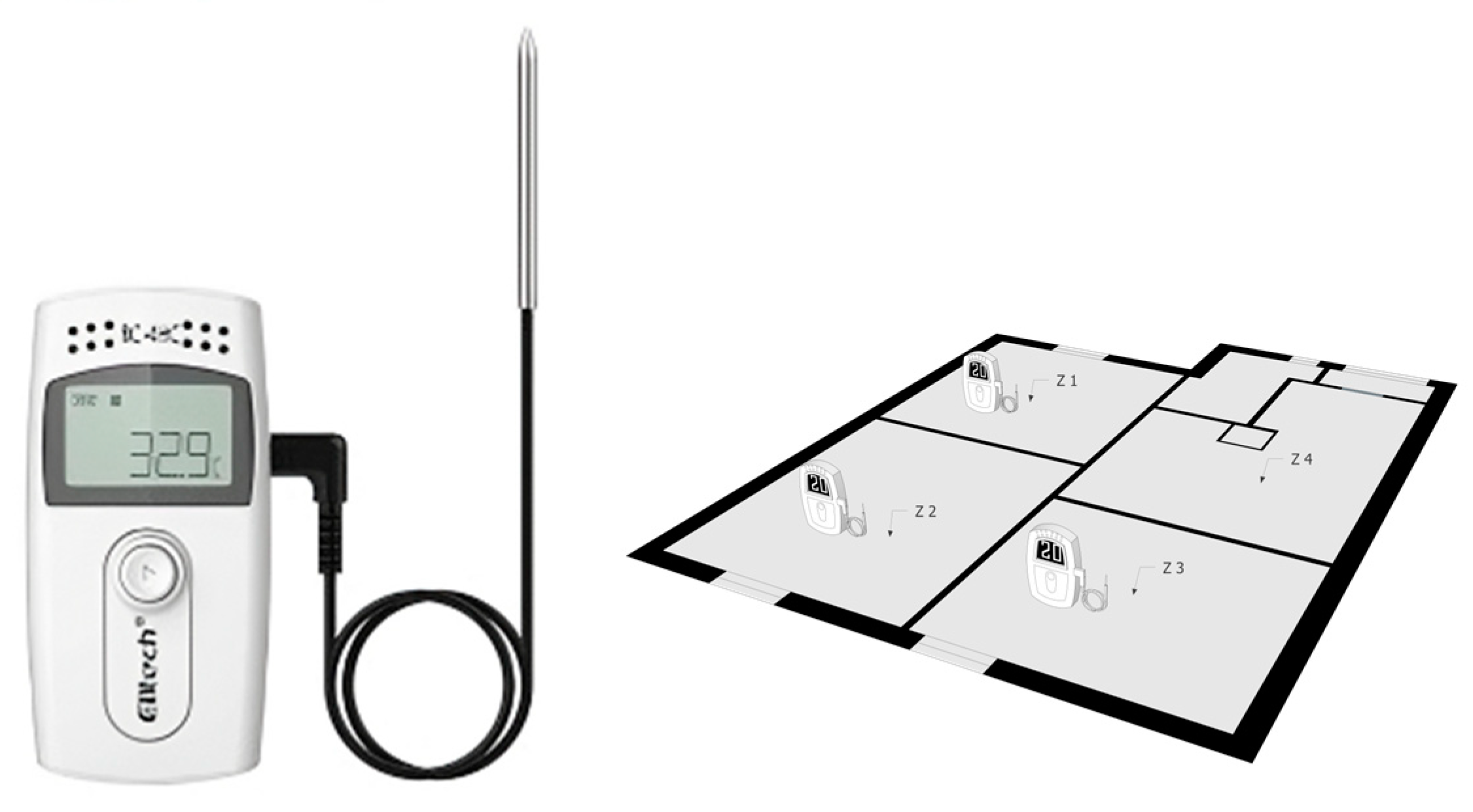
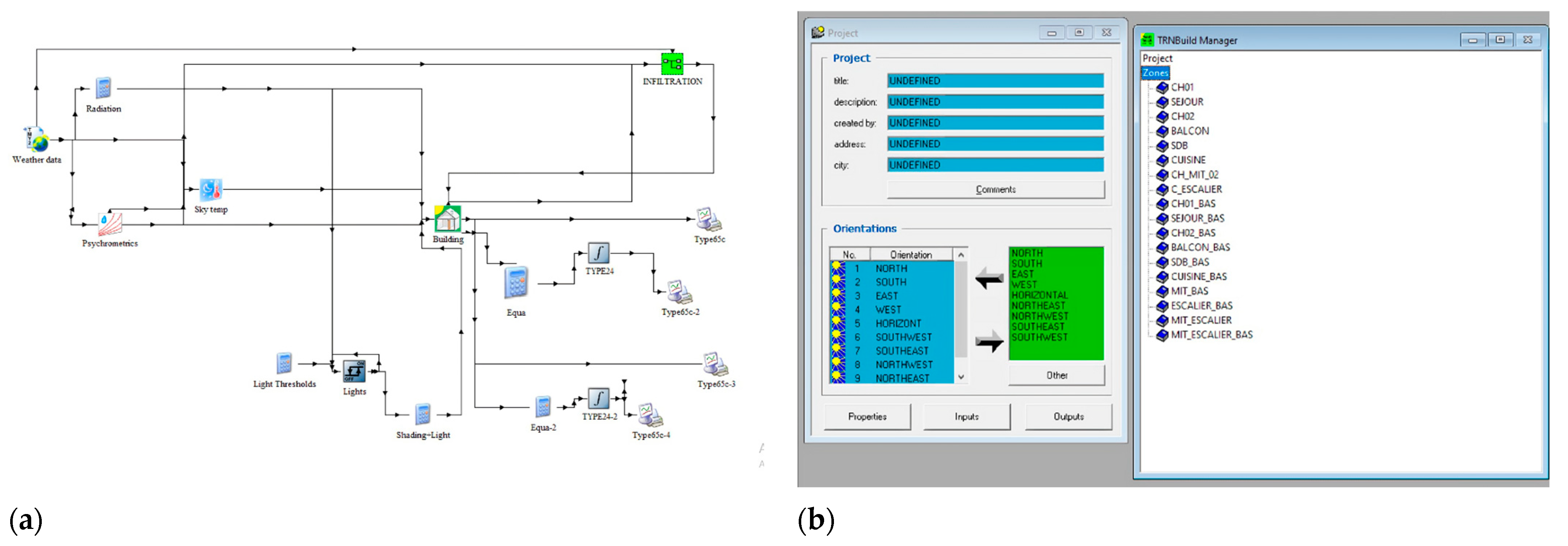
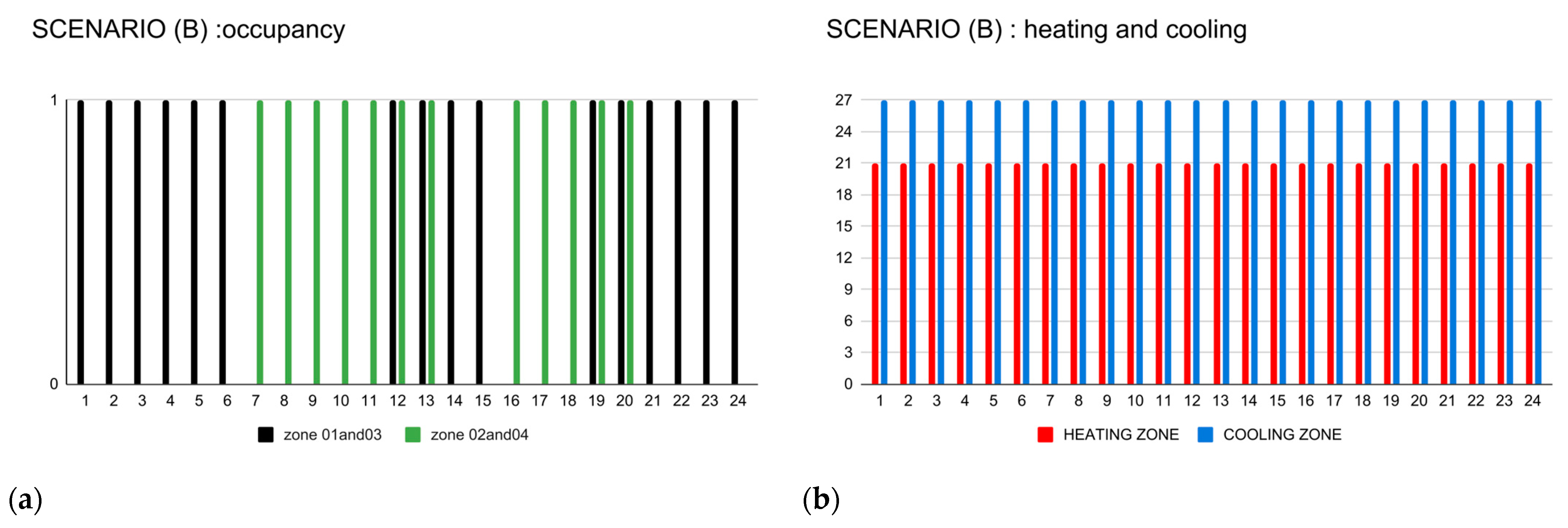



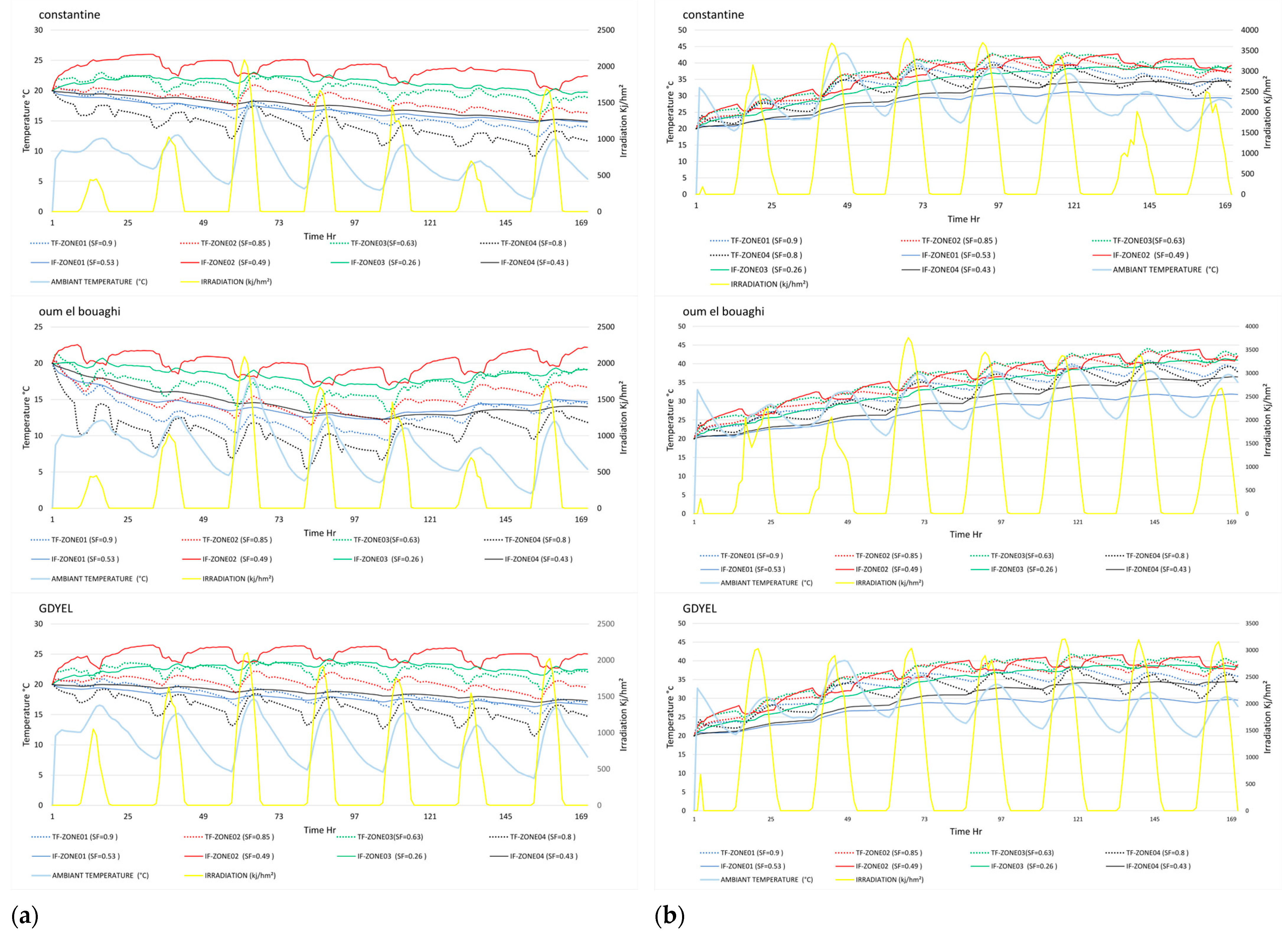



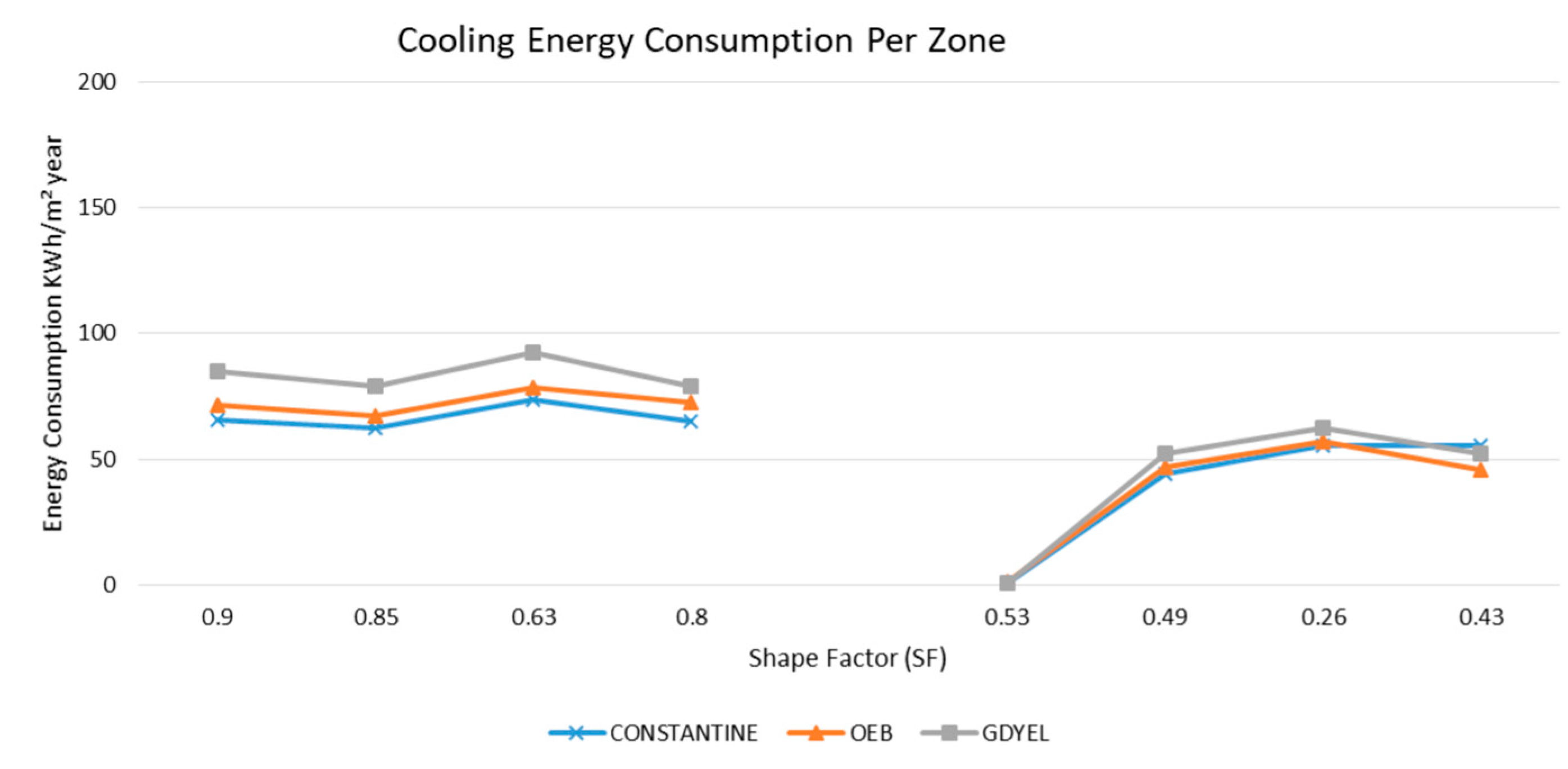
| Category | 2008 | 2019 |
|---|---|---|
| Housing Stock (units) | 6,872,541 | 9,845,692 |
| Population (ONS) | 34,080,030 | 43,900,000 |
| Urbanization Rate (%) | 65.77 | 70.00 |
| Housing Occupancy Rate | 5.1 | 4.46 |
| External Faces | Principal Orientation | Second Orientation | Roof | Shape Factor per Zone | Shape Factor per Floor | |
|---|---|---|---|---|---|---|
| Top Floor zone 01 | 3 | Northeast | Northwest | + | 0.90 | 0.57 |
| Top Floor zone 02 | 3 | Northeast | Northeast | + | 0.85 | |
| Top Floor zone 03 | 2 | Northeast | / | + | 0.63 | |
| Top Floor zone 04 | 2 | Northeast | / | + | 0.80 | |
| Inter-Floor zone 01 | 2 | Northeast | Northeast | / | 0.53 | 0.21 |
| Inter-Floor zone 02 | 2 | Northeast | Northeast | / | 0.49 | |
| Inter-Floor zone 03 | 1 | Northeast | / | / | 0.26 | |
| Inter-Floor zone 04 | 1 | Northeast | / | / | 0.43 |
| Envelope | Materials | Thickness (m) | Conductivity (W/m °C) | Conductivity (Kj/h m k) | Capacity (Kj/Kg K) | Density (Kg/m3) | U (W/m2 k) |
|---|---|---|---|---|---|---|---|
| External wall Double hollow brick | cement coating | 0.02 | 1.8 | 6.48 | 1 | 2200 | 0.555 |
| hollow brick | 0.10 | 0.5 | 1.8 | 0.87 | 1800 | ||
| Air Blade Coating | 0.05 | 0.047 | 0.1692 | 1 | 1 | ||
| hollow brick | 0.15 | 0.5 | 1.8 | 0.87 | 1800 | ||
| Plaster coating | 0.02 | 0.35 | 1.26 | 0.936 | 960 | ||
| Interior Wall | Plaster coating | 0.02 | 0.35 | 1.26 | 0.936 | 960 | 2.065 |
| hollow brick | 0.10 | 0.5 | 1.8 | 0.87 | 1800 | ||
| Plaster coating | 0.02 | 0.35 | 1.26 | 0.936 | 960 | ||
| Intermediate floor | Plaster coating | 0.02 | 0.35 | 1.26 | 0.936 | 960 | 2.391 |
| Concrete | 0.20 | 1.16 | 4.21 | 0.1 | 1372.2 | ||
| Cement coating | 0.02 | 1.3 | 4.68 | 1 | 2200 | ||
| Floor Tile | 0.02 | 3.6 | 0.94 | 2000 | |||
| Roof | Plaster coating | 0.02 | 0.35 | 1.26 | 0.936 | 960 | 2.458 |
| Concrete | 0.20 | 1.16 | 4.21 | 0.1 | 1372.2 | ||
| Waterproof layer | 0.01 | 1.15 | 4.14 | 1 | 1050 | ||
| Ground | Floor tile | 0.02 | 1 | 3.6 | 0.94 | 2000 | 2.771 |
| Cement coating | 0.015 | 1.3 | 4.68 | 1 | 1900 | ||
| Concrete | 0.20 | 1.16 | 4.21 | 0.1 | 1372.2 |
| Construction | K1 | K2 | K3 | Description |
|---|---|---|---|---|
| Tight | 0.10 | 0.11 | 0.034 | New building where special precautions have been taken to prevent infiltration. |
| Medium | 0.10 | 0.17 | 0.049 | Building constructed using conventional construction procedures. |
| Loose | 0.10 | 0.023 | 0.07 | Evidence of poor construction in older buildings where joints have separated. |
| Gain | Persons | Computer | Artificial Lighting | Other Gains |
|---|---|---|---|---|
| zone 01/02/03 (scenario (B)) | iso 7730 [44] Seated, light writing | 50 w | 19 w/m2 KVG; direct/40% Leuchstroffrohre | off |
| Schedule | scheduled occupancy zone 01-02-03 | BRIGHT | BRIGHT | off |
| zone 03 (scenario (A)) | off | off | off | off |
| schedule | off | off | off | off |
| zone 04 | iso 7730 Seated, eating | 50 w | 19 w/m2 KVG; direct/40% Leuchstroffrohre | FOUR 120 KJ/ |
| schedule | 1 | BRIGHT | BRIGHT | scheduled occupancy zone 04 |
| ASHRAE Guidelines 14-2002 [23] Hourly Criteria | Zone 02 with Internal Gains and Occupancy | Zone 03 without Internal Gains and Occupancy |
|---|---|---|
| NMBE ± 10% (%) | 3.19 | −1.64 |
| RMSE | 1.93 | 1.41 |
| CV (RMSE) 30% (%) | 9.73 | 7.57 |
| Envelope | D = Σ DT | Σ Dréf | CHECK C-3.2 | A = Σ APO + Σ AV | Aréf = ΣAPOréf + ΣAVréf | CHECK C-3.4 |
|---|---|---|---|---|---|---|
| ZONE 01 | 55.02 | 39.6 | 1.39 No conformity | 542.34 | 323.14 | 1.68 No conformity |
| ZONE 02 | 45.09 | 44.57 | 1.01 Compliant | 571.99 | 420.41 | 1.36 No conformity |
| ZONE 03 | 13.93 | 25.97 | 0.54 Compliant | 93.8 | 288.34 | 0.33 Compliant |
| ZONE 04 | 16.08 | 36.24 | 0.44 Compliant | 92.36 | 288.29 | 0.32 Compliant |
| Zone 01 | Zone 02 | Zone 03 | Zone 01 | Zone 02 | Zone 03 | ||
|---|---|---|---|---|---|---|---|
| Simulation duration (Hour) | 3547 | 3966 | 2850 | 3547 | 3966 | 2850 | |
| Maximum (Temperature), (°C) | 28.7 | 27.8 | 25 | Maximum (Humidity), (%) | 84.6 | 88.6 | 78.4 |
| Minimum (Temperature), (°C) | 17.6 | 15.6 | 16.03 | Minimum (Humidity), (%) | 49.5 | 46.9 | 45.1 |
| Average (Temperature), (°C) | 21.8 | 20.2 | 19.05 | Average (Humidity), (%) | 68.9 | 73.3 | 66.1 |
| Total Heating Energy Consumption (kWh/m2 Year) | Total Cooling Energy Consumption (kWh/m2 Year) | |||||||
|---|---|---|---|---|---|---|---|---|
| Experience Scenario (A) | Standard Scenario (B) | Experience Scenario (A) | Standard Scenario (B) | |||||
| Top Floor | Inter-Floor | Top Floor | Inter-Floor | Top Floor | Inter-Floor | Top Floor | Inter-Floor | |
| Constantine | 61.75 | 25.80 | 67.48 | 13.43 | 102.50 | 61.92 | 55.62 | 30.30 |
| Oum El Bouaghi | 64.35 | 27.66 | 83.90 | 11.14 | 104.561 | 62.92 | 60.42 | 31.86 |
| Gdyel | 48.91 | 18.25 | 37.30 | 4.40 | 107.51 | 64.78 | 69.98 | 35.70 |
|
Constantine kWh/m2 Year |
Oum el Bouaghi kWh/m2 Year |
Gdyel kWh/m2 Year | ||||
|---|---|---|---|---|---|---|
| Top Floor | Inter-Floor | Top Floor | Inter-Floor | Top Floor | Inter-Floor | |
| scenario (A) | 164.259921 | 87.7265873 | 168.916667 | 90.5900794 | 156.436111 | 83.0448413 |
| 65.19% | 34.81% | 65.09% | 34.91% | 65.32% | 34.68% | |
| 30.37% | 30.18% | 30.65% | ||||
| scenario (B) | 123.114476 | 43.7494484 | 144.325079 | 43.0083254 | 107.286754 | 40.1095476 |
| 73.78% | 26.22% | 77.04% | 22.96% | 72.79% | 27.21% | |
| 47.56% | 54.08% | 45.58% | ||||
|
Constantine
kWh/m2 Year |
Oum el Bouaghi
kWh/m2 Year |
Gdyel
kWh/m2 Year | ||||
|---|---|---|---|---|---|---|
| Scenario (A) | Scenario (B) | Scenario (A) | Scenario (B) | Scenario (A) | Scenario (B) | |
| Top Floor | 164.259921 | 123.114476 | 168.916667 | 144.325079 | 156.436111 | 107.286754 |
| 57.16% | 42.84% | 53.93% | 46.07% | 59.32% | 40.68% | |
| 14.32% | 7.85% | 18.64% | ||||
| Inter-Floor | 87.7265873 | 43.7494484 | 90.5900794 | 43.0083254 | 83.0448413 | 40.1095476 |
| 6.72% | 33.28% | 67.81% | 32.19% | 67.43% | 32.57% | |
| 33.45% | 35.62% | 34.86% | ||||
| Zone | External Faces | Orientation | Roof (m2) | SF | Heating Energy Consumption (kWh/m2) | Cooling Energy Consumption (kWh/m2) | |||||
|---|---|---|---|---|---|---|---|---|---|---|---|
| Principal (m2) | Secondary (m2) | Constantine | OEB | Gdyel | Constantine | OEB | Gdyel | ||||
| TF (Top Floor) | |||||||||||
| 01 | 3 | NE 10.09 | NW 10.31 | 13.76 | 0.9 | 79.44 | 89.21 | 33.10 | 65.38 | 71.40 | 84.93 |
| 02 | 3 | SW 10.09 | NW 12.83 | 16.52 | 0.85 | 76.63 | 81.62 | 27.40 | 62.17 | 67.19 | 78.76 |
| 03 | 2 | SW 9.57 | / | 13.05 | 0.63 | 54.71 | 59.16 | 15.56 | 73.58 | 78.28 | 92.21 |
| 04 | 2 | NE 4.67 | / | 15.49 | 0.80 | 190.69 | 193.18 | 106.19 | 65.17 | 72.48 | 79.14 |
| IF (Inter-Floor) | |||||||||||
| 01 | 2 | NE 10.09 | NW 10.31 | / | 0.53 | 46.05 | 49.98 | 19.65 | 0.78 | 1.11 | 0.64 |
| 02 | 2 | SW 10.09 | NW 12.83 | / | 0.49 | 4.20 | 6.52 | 0.19 | 44.40 | 46.60 | 52.34 |
| 03 | 1 | SW 9.57 | / | / | 0.26 | 2.37 | 4.03 | 0.04 | 55.35 | 56.87 | 62.36 |
| 04 | 1 | NE 4.67 | / | / | 0.43 | 18.17 | 22.91 | 2.78 | 55.35 | 45.61 | 52.42 |
Disclaimer/Publisher’s Note: The statements, opinions and data contained in all publications are solely those of the individual author(s) and contributor(s) and not of MDPI and/or the editor(s). MDPI and/or the editor(s) disclaim responsibility for any injury to people or property resulting from any ideas, methods, instructions or products referred to in the content. |
© 2024 by the authors. Licensee MDPI, Basel, Switzerland. This article is an open access article distributed under the terms and conditions of the Creative Commons Attribution (CC BY) license (https://creativecommons.org/licenses/by/4.0/).
Share and Cite
Hadji, I.; Mazouz, S.; Mokhtari, A.M.; Benzaama, M.-H.; El Mendili, Y. Multi-Zone Energy Performance Assessment of Algerian Social Housing Using a Parametric Approach. Buildings 2024, 14, 1587. https://doi.org/10.3390/buildings14061587
Hadji I, Mazouz S, Mokhtari AM, Benzaama M-H, El Mendili Y. Multi-Zone Energy Performance Assessment of Algerian Social Housing Using a Parametric Approach. Buildings. 2024; 14(6):1587. https://doi.org/10.3390/buildings14061587
Chicago/Turabian StyleHadji, Ikram, Said Mazouz, Abderrahmane Mejedoub Mokhtari, Mohammed-Hichem Benzaama, and Yassine El Mendili. 2024. "Multi-Zone Energy Performance Assessment of Algerian Social Housing Using a Parametric Approach" Buildings 14, no. 6: 1587. https://doi.org/10.3390/buildings14061587






